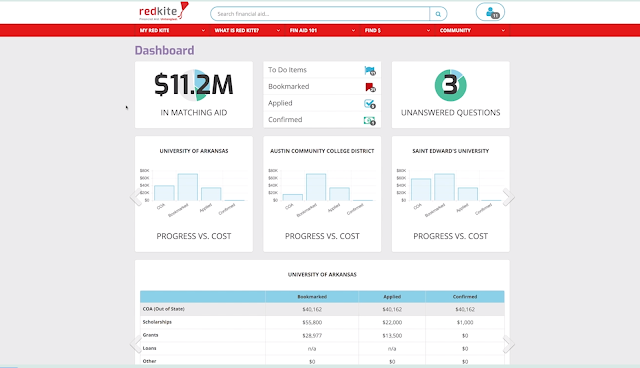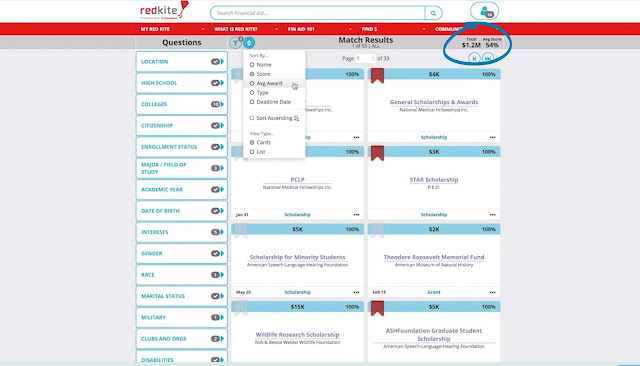Four Myths About Financial Aid: Busted!
Depending upon the school and other factors, there may also be sources of free money for college such as endowments for specific majors in the arts. Many students and their families are pleasantly surprised to learn how much aid they are actually eligible or qualified to receive. Red Kite, integrated within the GATE College System platform, makes sure students are on-track with confidence to know they can afford to aspire, no matter what their background might be. Here are a few common myths that students and their families may believe about financial aid and why these are incorrect:
THE KEY:
Students must be given the means to easily apply to qualify for financial aid. That's why GATE College System and Red Kite are so important to their outcomes.



Myth 1: All Rules Governing Financial Aid Are The Same? False.
While the Free Application for Federal Student Aid (FAFSA) can be intimidating, this application is the gateway to receive money from the federal government. Even if students are not eligible for federal aid or the amount of offered aid is not enough for a full degree, other providers of financial aid (including the colleges themselves) may rely on the FAFSA as a starting point. They released a handy mobile app in October 2018 that makes this process quick and easy. While each institution will have its own interpretation of how much need they will cover, it all starts with the FAFSA.
GATE's Red Kite integration helps students easily identify the gap between what the federal government determines as their Estimated Family Contribution (EFC) and the Cost of Attendance. Tactically identifying and applying for other means of aid is what it's all about--and as students realize money need not be a barrier, many find their confidence leads to improved academic performance and emotional outlook.
Students must be given the means to easily apply to qualify for financial aid. That's why GATE College System and Red Kite are so important to their outcomes.
Myth 1: All Rules Governing Financial Aid Are The Same? False.
While the Free Application for Federal Student Aid (FAFSA) can be intimidating, this application is the gateway to receive money from the federal government. Even if students are not eligible for federal aid or the amount of offered aid is not enough for a full degree, other providers of financial aid (including the colleges themselves) may rely on the FAFSA as a starting point. They released a handy mobile app in October 2018 that makes this process quick and easy. While each institution will have its own interpretation of how much need they will cover, it all starts with the FAFSA.
GATE's Red Kite integration helps students easily identify the gap between what the federal government determines as their Estimated Family Contribution (EFC) and the Cost of Attendance. Tactically identifying and applying for other means of aid is what it's all about--and as students realize money need not be a barrier, many find their confidence leads to improved academic performance and emotional outlook.
Myth 2: Private schools are always more expensive than state schools? False.
The EFCis the same regardless of which school a student plans to attend. Looking at the sticker price can be the main factor in trying to build a list for novices. In GATE they learn to negotiate and strategize how to optimize their free tuition and fees. Similar to buying a used car, this is not about finding the most inexpensive option possible. Large state schools and universities often receive financial assistance from their state governments to help make them more affordable, but many private schools that publish a high tuition rate actually have very large endowments from alumni, local business, and other donors, enabling these private schools to discount their tuition and offer very handsome financial aid packages for desirable candidates.
GATE helps students optimize GPAs, maximize test scores and create outstanding essays in its G-A-T-E sequence, which coupled with Red Kite's scholarship application ease makes a world of difference for first generation and other socioeconomically disadvantaged students.
Myth 3: Out-of-state schools are always more expensive? False.
Colleges and universities publish an increased rate of tuition for out-of-state students, whose permanent residence is elsewhere. If a student wants to study oceanography or marine biology and wildlife, they may need to move near an ocean. However, few want to pay the increase in costs for out-of-state students. College tuition can be negotiated if the school wants to recruit a student, and of late this tends to be most common for majors in one of the STEM fields. A well-balanced list will include both in-state and out-of-state options--GATE helps students identify the right-fit schools while keeping the financial equation squarely in view.
Myth 4: Scholarships are mostly for athletes? False.
Millions of dollars in scholarships is left unclaimed every year, from donors that are exceptionally far-reaching. Some scholarships are based on athletics or need, but many are merit-based instead. For example, many schools offer scholarships for athletics but they also offer scholarships for academic achievement, essay contests, particular majors, and other criteria. In addition, scholarships are often available through local businesses, banks, credit unions or churches--but if a student doesn't know it exists, he or she can't apply. There are many national contests for scholarships including fun ones ones for things like candy recipes.
Red Kite's help for students within the GATE platform means they access not only widely publicized opportunities that tend to be more competitive and time-consuming, but also hundreds of unusual scholarships, like ones for students who can demonstrate an understanding of copyrights, can show an ability to work with fire sprinklers, can attest they do not use tobacco, or even qualify by being unusually tall or left handed. There are even scholarships for students who have certain last names! Red Kite helps locate and collate, so all GATE students access every penny out there they can and should apply to receive.
THE KEY:
Find & Apply
Millions of dollars’ worth of scholarships go unused every year, simply because no one applies for them.
Until GATE and Red Kite, most public schools lacked the resources to help students do all the searching for scholarships. Never again will a budget-constrained district have its hands tied when it comes to getting aid for its students. In these days of a national average of 482 students per one college counselor, with 1000 to one ratios in some large urban centers, digital support can make a significant impact, improving the future for millions of deserving students.



Comments
Post a Comment